Gadara
Gadara (Hebrew: גדרה, Gadʾara, or גדר, Gader; Greek: Γάδαρα Gádara), in some texts Gedaris, was an ancient Hellenistic city, for a long time member of the Decapolis city league, a former bishopric and present Latin Catholic titular see.
 Church terrace at ancient Gadara | |
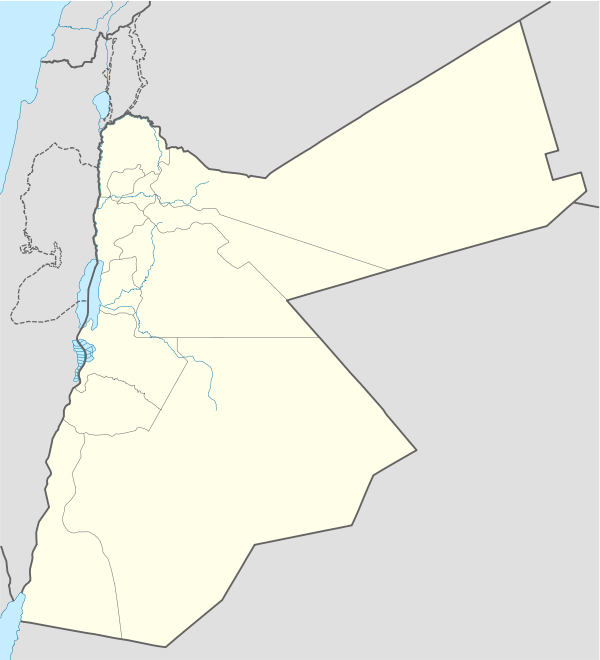 Shown within Jordan | |
| Location | |
|---|---|
| Coordinates | 32°39′15″N 35°41′15″E |
| Site notes | |
| Condition | Ruins |
Its ruins are today located at Umm Qais, a small town in the Bani Kinanah Department and Irbid Governorate in Jordan, near its borders with Israel and Syria. It stood on a hill 378 metres (1,240 ft) above sea level overlooking the Yarmouk River gorge, with the Golan Heights and the Sea of Galilee well visible to the north and northwest.
History
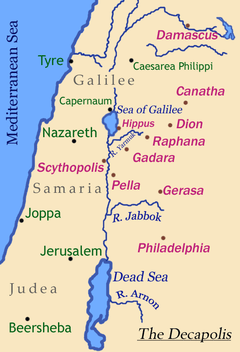
Gadara was situated in a defensible position on a ridge accessible to the east but protected by steep falls on the other three sides. It was well-watered, with access to the Ain Qais spring and cisterns.[1]
During the Hellenistic and Roman periods, Gadara was a centre of Greek culture in the region, considered one of its most Hellenised[2] and enjoying special political and religious status.[3]
Hellenistic period
By the third century BC the town was already of some cultural importance. It was the birthplace of the satirist Menippus (3rd century BCE), a slave who became a Cynic philosopher and satirised the follies of mankind in a mixture of prose and verse.[4] His works have not survived, but were imitated by Varro and by Lucian.> In the early first century BC Gadara gave birth to its most famous son, Meleager. He was one of the most admired Hellenistic Greek poets, not only for his own works but also for his anthology of other poets, which formed the basis of the large collection known as the Greek Anthology.
The Greek historian Polybius describes Gadara as being in 218 BC the "strongest of all places in the region". Nevertheless, it capitulated shortly afterwards when besieged by the Seleucid king Antiochus III of Syria. Under the Seleucids, it was also known as Antiochia (Ancient Greek: Αντιόχεια) or Antiochia Semiramis (Ancient Greek: Ἀντιόχεια Σεμίραμις, Antiókheia Semíramis) and as Seleucia (Ancient Greek: Σελεύκεια).[5] The region passed in and out of the control of the Seleucid kings of Syria and the Ptolemies of Egypt. Gadara was captured and damaged by Alexander Jannaeus.[6][7]
Roman period
In 63 BC, when the Roman general Pompey placed the region under Roman control, rebuilt Gadara and made it one of the semi-autonomous cities of the Roman Decapolis,[8][3] and a bulwark against Nabataean expansion. But in 30 BC Augustus placed it under the control of the Jewish king Herod. Jewish-Roman historian Josephus relates that after King Herod's death in 4 BC, Gadara was made part of the Roman province of Syria.[9]
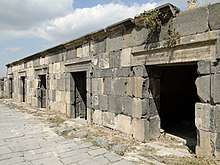
Josephus relates that in AD 66, at the beginning of the Jewish revolt against the Romans, the country around Gadara was laid waste,[10]
"So Vespasian marched to the city of Gadara. He came into it and slew all the youth, the Romans having no mercy on any age whatsoever. He set fire to the city and all the villas around it."[11]
The Gadarenes captured some of the boldest of the Jews, of whom several were put to death and others imprisoned.[12] Some in the town surrendered to emperor Vespasian, who placed a garrison there.[13]
The 2nd century AD Roman aqueduct to Gadara supplied drinking water through a qanat 170 km (110 mi) long. Its longest underground section, running for 94 km, is the longest known tunnel from ancient times.[1][14]
Byzantine and Early Muslim periods
Gadara continued to be an important town within the Eastern Roman Empire, and was long the seat of a Christian bishop.[15]
With the conquest of the Arabs, following the Battle of Yarmouk in 636 it came under Muslim rule. Around 749 it was largely destroyed by an earthquake, and was abandoned.
Gadara in the Gospels
The synoptic Gospels mention the Exorcism of the Gerasene demoniac, with some ancient manuscripts replacing Gerasene with Gadarene or Gergesene.
Ecclesiastical history
Ancient Gadara was important enough to become a suffragan bishopric of the Metropolitan Archbishopric of Scythopolis, the capital of the Roman province of Palestina Secunda, but it faded with the city after the Muslim conquest.
Titular see
The diocese was nominally restored no later than the 15th century as Titular bishopric of Gadaræ in Latin of Gadara in Curiate Italian, from 1925 renamed solely Gadara.
It is vacant, having had the following incumbents, all of the fitting episcopal (lowest) rank :
- Johann Erler, Friars Minor (O.F.M.) (1432.07.12 – 1469)
- Matthias Kanuti, Benedictine Order (O.S.B.) (1492.07.09 – 1506)
- Domingo Pérez Rivera (1741.03.06 – 1771.11.12)
- Jan Benisławski, Jesuits (S.J.) (1783 – 1812.03.25)
- Anton Gottfried Claessen (1844.07.25 – 1847.09.29)
- Joseph-Hyacinthe Sohier, Paris Foreign Missions Society (M.E.P.) (1850.08.27 – 1876.09.03)
- Edward MacCabe (1877.06.26 – 1879.04.04) (later Cardinal)
- Giuseppe Macchi (1880.02.27 – 1889.04.03) (later Archbishop)
- Giuseppe Schirò (1889.07.30 – 1895.11.29) (later Archbishop)
- Nicolae Iosif Camilli, Conventual Franciscans (O.F.M. Conv.) (1896.02.25 – 1901.03.27) (later Archbishop)
- Venceslao Frind (1901.07.15 – 1932.09.02)
- Martial-Pierre-Marie Jannin, M.E.P. (1933.01.10 – 1940.07.16)
- Jean Cassaigne, M.E.P. (1941.02.20 – 1973.10.31)
Notable inhabitants
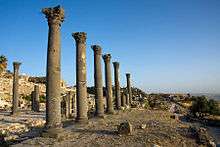
Gadara was once called the "city of philosophers".[16] David Sider notes that Gadara was produced numerous remarkable philosophers, writers and mathematicians, but in spite of that and of being large enough to boast two theatres, it saw all its famous sons move to Greece and Italy in search of career opportunities.[17] Among others, Gadara was home to (chronologically):
- Menippus of Gadara (3rd century BCE), Cynic satirist[18][17][4]
- Meleager of Gadara (1st century BCE), Cynic philosopher and poet[18][17][19]
- Philodemus of Gadara (1st century BCE), Epicurean philosopher and poet[18][17][4]
- Theodorus of Gadara (1st century BCE), orator[18][17][4]
- Philo of Gadara (early 2nd century CE), mathematician, calculated a highly accurate value for π[20][17]
- Oenomaus of Gadara (2nd century CE), Cynic philosopher[18][17]
- Apsines of Gadara (3rd century CE), rhetorician[18][17]
Rediscovery
Umm Qais was recognised by Ulrich Seetzen in 1806 as the ancient site of Gadara.[21]
Description
The ancient walls may now be traced in almost their entire circuit of 3 km. One of the Roman roads ran eastward to Ḍer‛ah; and an aqueduct has been traced to the pool of Ḳhab, about 20 miles to the north of Ḍer‛ah. The ruins include those of "baths, two theaters, a hippodrome, colonnaded streets and, under the Romans, aqueducts,"[22] a temple, a basilica and other buildings, telling of a once splendid city. A paved street, with double colonnade, ran from east to west. The ruts worn in the paved road by the wheels of ancient vehicles are still to be seen.
In 2017, archaeologists discovered an ancient temple that was built in the Hellenistic era in the 3rd century BC. The temple is believed to have been dedicated to Poseidon. Hellenistic pottery was also found on the site.[23] The temple, built following the design of distyle in antis, consists of a pronaos, a podium and a naos, the holy chamber of the temple.[24]
Archaeologists have also discovered a network of water tunnels at the centre of the ancient town, which are separated from the external tunnel that was discovered decades ago in the area.[24]
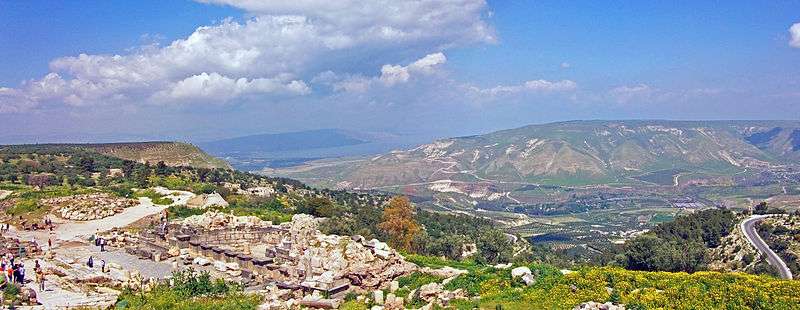
Tourism

The formerly residence of the Ottoman governor known as Beit Rousan ("Rousan House") serves as a visitor centre and museum, where numerous archaeological finding from Gadara are on display.
References
Citations
- Schram, Wilke D. (2007), "Gadara (Jordan)", Roman Aqueducts, retrieved 25 September 2015.
- Rocca, Samuel (2008), Herod's Judea: A Mediterranean State in the Classic World, Eugene: Mohr Siebeck, p. 200, ISBN 978-1-4982-2454-3
- Mare, W. Harold (2000), "Decapolis", Eerdmans Dictionary of the Bible, Grand Rapids: Wm. B. Eerdmans Publishing, pp. 333–334, ISBN 0-8028-2400-5.
- Strabo's Geography 16.2.29
- Calmet, Augustin (1813). Calmet's Great Dictionary of the Holy Bible. Samuel Etheridge.
- Israel Shatzman, The Armies of the Hasmonaeans and Herod: From Hellenistic to Roman Frameworks, p. 74.
- Piotrkowski, Meron M. (2011). "When Did Alexander Yannai Capture Which Gadara?". Jewish Studies Quarterly. Mohr Siebeck GmbH & Co. KG. 18 (3): 266–276. JSTOR 41289144.
- Fitzgerald, John Thomas; Obbink, Dirk D.; Holland, Glenn Stanfield (2004). Philodemus and the New Testament world [electronic resource]. BRILL. pp. 365–366. ISBN 9789004114609.
- Josephus Antiquities, XVII, xi, 4; Josephus, Bellum Judaicum, II, vi, 3.
- Josephus, Bellum Judaicum, II, xviii, 1.
- Josephus, Wars of the Jews, Book 7.
- Josephus, Bellum Judaicum, 5.
- Josephus, Bellum Judaicum, IV, vii, 3.
- Mathias Döring: "Wasser für Gadara. 94 km langer Tunnel antiker Tunnel im Norden Jordaniens entdeckt", in: Querschnitt, Vol. 21 (2007), pp. 24–35
- Reland, Palestine, 776.
- Desmond, William. Cynics. p36
- Sider, David (1997). The Epigrams of Philodemos: Introduction, Text, and Commentary. Oxford University Press. p. 4. ISBN 9780195356670. Retrieved 3 June 2020.
- Blank, David, "Philodemus", The Stanford Encyclopedia of Philosophy (Spring 2019 Edition), Edward N. Zalta (ed.), accessed 3 June 2020.
- Isaac, Benjamin (2017). Empire and Ideology in the Graeco-Roman World. Cambridge: Cambridge University Press. p. 427c. ISBN 978-1-107-13589-5. Retrieved 3 June 2020.CS1 maint: ref=harv (link)
- Runia, David T. (1995). Philo and the Church Fathers: A Collection of Papers. Vigiliae Christianae, Supplements. Volume XXXII. BRILL. p. 27. ISBN 9789004312999. Retrieved 3 June 2020.
- Schürer, 1891, §23 (The Hellenistic Towns), p. 100 (note 179), where he cites Seetzen, Reisen durch Syrien (ed. by Kruse, 4 vols. 1854–59), i. 369 sqq., iv. 188 sqq.
- Desmond, William. Cynics. p36 - referencing (Weber & Khouri 1989:17-18)
- "Archaeologists discover ancient temple in Jordan's Amman".
- "'First of-its-kind' Hellenistic temple discovered in Umm Qais". Jordan Times. August 14, 2017.
Bibliography
- Holm-Nielson, Svend, "Gadarenes", in Anchor Bible Dictionary vol. 2, ed. D.N. Freedman (1992. New York: Doubleday)
- Laney, J. Carl, Geographical Aspects of the Life of Christ [Unpublished Th.D. dissertation, Dallas Theological Seminary ] (1977)
- Nun, Mendel, Gergesa (Kursi) (1989 Kibbutz Ein Gev)
- Nun, Mendel, Ports of Galilee, in Biblical Archaeology Review; 25/4: 18 (1999)
- Schürer, E. (1891). Geschichte des jüdischen Volkes im Zeitalter Jesu Christi [A History of the Jewish People in the Time of Jesus Christ]. 1. Translated by Miss Taylor. New York: Charles Scribner's Sons.
- Weber, Thomas, Umm Qais: Gadara of the Decapolis (1989. Amman: Economic Press Co.)
- This entry incorporates text from the International Standard Bible Encyclopedia with some modernisation.
External links
| Wikimedia Commons has media related to Umm Qais. |
- GCatholic - (titular) bishopric
- Irbid Guide (in Arabic)
- Greater Irbid Municipality (in Arabic)
- Irbid news (in Arabic)
- History and pictures